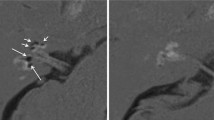Abstract
The objective of the present study was to investigate endolymphatic space images in patients with fluctuating hearing loss without vertigo, and to elucidate its underlying pathophysiology. Eight patients with fluctuating hearing loss without vertigo were included in this study. 3T MRI was taken, 24 h after intratympanic injection of gadolinium-diethylenetriamine pentaacetic acid (Gd-DTPA). Electrocochleography and VEMP tests were performed to evaluate cochlear and vestibular functions. Endolymphatic hydrops were observed both in the cochlea and in the vestibule of all eight patients. Three patients out of six whose summating potential/action potential (SP/AP) ratio was recordable showed an elevation of SP/AP ratio. In the two patients with remarkable endolymphatic hydrops in the vestibule, VEMP was absent from the affected ear. In conclusion, 3T MRI after intratympanic injection of Gd-DTPA revealed endolymphatic hydrops both in the cochlea and in the vestibule in the patients with fluctuating hearing loss without vertigo.



Similar content being viewed by others
References
Yamakawa K (1938) Uber die pathologisch Veranderung bei einem Meniere-Kranken. J Otorhinolaryngol Soc Jpn 4:2310–2312
Hallpike SC, Cairns H (1938) Observations on the pathology of Meniere’s syndrome. J Laryngol Otol 53:625–655. doi:10.1017/S0022215100003947
Alford BR (1972) Report of subcommittee on equilibrium and its measurement. Meniere’s disease: criteria for diagnosis and evaluation of therapy for reporting. Trans Am Acad Ophthalmol Otolaryngol 76:1462–1464
Williams HL (1950) Endolymphatic hydrops without vertigo. Arch Otolaryngol 51:557–581
Lindsay JR, von Schulthess G (1958) An usual case of labyrinthine hydrops. Acta Otolaryngol 49:315–324. doi:10.3109/00016485809134760
Kohut RI, Lindsay JR (1972) Pathologic changes in idiopathic labyrinthine hydrops. Acta Otolaryngol 73:402–412. doi:10.3109/00016487209138959
Altmann F, Kornfield M (1965) Histological studies of Meniere’s disease. Ann Otol Rhinol Laryngol 74:915–943
Pearson BW, Brackmann DE (1985) Committee on hearing and equilibrium guidelines for reporting treatment results in Meniere’s disease. Otolaryngol Head Neck Surg 93:579–582
American Academy of Otolaryngology-Head and Neck Surgery Foundation, Inc (1995) Committee on hearing and equilibrium guidelines for the diagnosis and evaluation of therapy in Meniere’s disease. Otolaryngol Head Neck Surg 113:181–185
Nakashima T, Naganawa S, Sugiura M et al (2007) Visualization of endolymphatic hydrops in patients with Meniere’s disease. Laryngoscope 117:415–420. doi:10.1097/MLG.0b013e31802c300c
Naganawa S, Satake H, Iwano S et al (2008) Imaging endolymphatic hydrops at 3 tesla using 3D-FLAIR with intratympanic Gd-DTPA administration. Magn Reson Med Sci 7:85–91. doi:10.2463/mrms.7.85
Naganawa S, Satake H, Kawamura M et al (2008) Separate visualization of endolymphatic space, perilymphatic space and bone by a single pulse sequence; 3D-inversion recovery imaging utilizing real reconstruction after intratympanic Gd-DTPA administration at 3 Tesla. Eur Radiol 18:920–924. doi:10.1007/s00330-008-0854-8
Naganawa S, Sugiura M, Kawamura M et al (2008) Imaging of endolymphatic and perilymphatic fluid at 3T after intratympanic administration of gadolinium-diethylene-triamine pentaacetic acid. AJNR Am J Neuroradiol 29:724–726. doi:10.3174/ajnr.A0894
Griswold MA, Jakob PM, Heidemann RM et al (2002) Generalized autocalibrating partially parallel acquisitions (GRAPPA). Magn Reson Med 47:1202–1210. doi:10.1002/mrm.10171
Salt AN, Henson MM, Gewalt SL et al (1995) Detection and quantification of endolymphatic hydrops in the guinea pig cochlea by magnetic resonance microscopy. Hear Res 88:79–86. doi:10.1016/0378-5955(95)00103-B
Shinomori Y, Spack DS, Jones DD, Kimura RS (2001) Volumetic and dimensional analysis of the guinea pig inner ear. Ann Otol Rhinol Laryngol 110:91–98
Buckingham RA, Valvassori GE (2001) Inner ear fluid volumes and the resolving power of magnetic resonance imaging: can it differentiate endolymphatic structures? Ann Otol Rhinol Laryngol 110:113–117
Merchant SN, Adams JC, Nadol JB Jr (2005) Pathophysiology of Meniere’s syndrome: are symptoms caused by endolymphatic hydrops? Otol Neurotol 26:74–81. doi:10.1097/00129492-200501000-00013
Dornhoffer JL (1998) Diagnosis of cochlear Meniere’s disease with electrocochleography. ORL J Otorhinolaryngol Relat Spec 60:301–305. doi:10.1159/000027614
Kariya S, Cureoglu S, Fukushima H et al (2007) Histopathologic changes of contralateral human temporal bone in unilateral Meniere’s disease. Otol Neurotol 28:1063–1068
Schuknecht HF, Gulya AJ (1983) Endolymphatic hydrops. An overview and classification. Ann Otol Rhinol Laryngol Suppl 106:1–20
Schuknecht HF, Belal AA (1975) The utriculo-endolymphatic valve: its functional significance. J Laryngol Otol 89:985–996. doi:10.1017/S0022215100081305
Kitahara M, Takeda T, Yazawa Y et al (1984) Pathophysiology of Meniere’s disease and its subvarieties. Acta Otolaryngol Suppl 406:52–55
Dugue B, Leppanen EA, Teppo AM et al (1993) Effects of psychological stress on plasma interleukins-1 beta and 6, C-reactive protein, tumour necrosis factor alpha, anti-diuretic hormone and serum cortisol. Scand J Clin Lab Invest 53:555–561. doi:10.3109/00365519309092553
Charmandari E, Tsigos C, Chrousos G (2005) Endocrinology of the stress response. Annu Rev Physiol 67:259–284. doi:10.1146/annurev.physiol.67.040403.120816
Takeda T, Kakigi A, Saito H (1995) Antidiuretic hormone (ADH) and endolymphatic hydrops. Acta Otolaryngol Suppl 519:219–222. doi:10.3109/00016489509121909
Takeda T, Takeda S, Kitano H et al (2000) Endolymphatic hydrops induced by chronic administration of vasopressin. Hear Res 140:1–6. doi:10.1016/S0378-5955(99)00180-X
Sawada S, Takeda T, Kitano H et al (2002) Aquaporin-2 regulation by vasopressin in the rat inner ear. Neuroreport 13:1127–1129. doi:10.1097/00001756-200207020-00011
Ferraro JA, Durrant JD (2006) Electrocochleography in the evaluation of patients with Meniere’s disease/endolymphatic hydrops. J Am Acad Audiol 17:45–68. doi:10.3766/jaaa.17.1.6
Lin MY, Timmer FC, Oriel BS et al (2006) Vestibular evoked myogenic potentials (VEMP) can detect asymptomatic saccular hydrops. Laryngoscope 116:987–992. doi:10.1097/01.mlg.0000216815.75512.03
Ikino CM, de Almeida ER (2006) Summating potential-action potential waveform amplitude and width in the diagnosis of Meniere’s disease. Laryngoscope 116:1766–1769. doi:10.1097/01.mlg.0000227976.43352.61
Gibson WPR (1990) Electrocochleography: a comparison of clicks versus tone bursts in the diagnosis of endolymphatic hydrops. Proceedings of 3rd international symposium on Meniere’s disease, Snowmass-Aspen, pp 281–285
Arenberg IK, Bohlen HK (1992) Diagnosis of endolymphatic hydrops using transtympanic electrocochleography. First international conference on ECoG/otoacoustic emissions and electrophysiologic monitoring, Wurzburg
de Waele C, Huy PT, Diard JP et al (1999) Saccular dysfunction in Meniere’s disease. Am J Otol 20:223–232. doi:10.1016/S0196-0709(99)90004-2
Acknowledgments
This study was supported by research grants from the Ministry of Health, Labor, and Welfare and from the Ministry of Education, Culture, Sports, Science, and Technology of Japan.
Author information
Authors and Affiliations
Corresponding author
Rights and permissions
About this article
Cite this article
Teranishi, M., Naganawa, S., Katayama, N. et al. Image evaluation of endolymphatic space in fluctuating hearing loss without vertigo. Eur Arch Otorhinolaryngol 266, 1871–1877 (2009). https://doi.org/10.1007/s00405-009-0989-5
Received:
Accepted:
Published:
Issue Date:
DOI: https://doi.org/10.1007/s00405-009-0989-5




